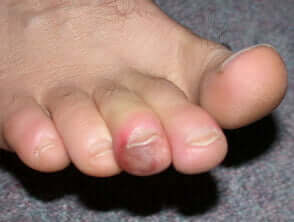Help with Chilblains

What are chilblains?
Chilblains are small reddish, purple itchy, painful swellings that happen on the feet, and other extremities, in reaction to cold temperatures. They can either be flat or raised, and can cause the skin to split. On the feet, they commonly occur on the ends and underneath of the toes, or on the underneath of the foot where it comes into contact with the ground.
Chilblains causes and treatment
How do chilblains form?
Chilblains happen when the tiny blood vessels under the skin close up in reaction to the cold. When the skin warms up again, the blood rushes back and this causes some of it to leak into the surrounding tissue which can’t deal with the increased volume of blood.
Not everyone gets chilblains, although anyone can develop them, but people with poor circulation, those who work in cold, damp conditions, and people taking certain medications are more at risk.
Abrupt changes in temperatures can make them worse, such as coming inside from the cold and warming your feet on a radiator or underfloor heating.
How do I treat them?
- Try not to break the skin. Chilblains can itch, but try not to scratch them too much.
- Applying iodine, Friar’s Balsam or Balmosa can help.
- Keep your feet at a steady temperature, don’t let them get too cold or too warm.
- Wear shoes with a thick sole or use a thermal insole.
- Keep your whole body warm, wear long socks and layers. Wearing two pairs of socks can help, socks made of natural fibres like merino wool or bamboo are great. Even two thin layers of socks are better than one.
- If your chilblains do break down and are slow to heal, make an appointment with a podiatrist to have them checked over and for more advice on healing them.
If you want to know more about Raynauds and it's association with chilblains, you can read our blog post here
DermnetNZ also have a great article on chilblains here
Frequently Asked Questions (FAQs)
Podiatrists treat chilblains feet by:
1. Topical Treatments: Applying certain creams and emollients to reduce inflammation and keep the skin moisturised.
2. Medications: We can request that your GP prescribes vasodilators like nifedipine to improve blood flow, and antibiotics if there's an infection.
3. Protective Measures: Advising on wearing warm clothing and avoiding cold exposure.
4. Monitoring: Scheduling follow-up appointments to adjust treatments as needed.
5. Addressing Underlying Conditions: Managing circulatory or systemic issues contributing to chilblains on foot.
Symptoms of chilblains can be poor circulation or a response to cold weather. In some cases, they might be related to conditions like Raynaud's phenomenon or autoimmune disorders. Keeping your extremities warm and dry can help prevent chilblains. If you're experiencing them frequently or severely, it might be a good idea to consult a healthcare professional for a more thorough evaluation.
A deficiency in vitamin D can contribute to the development of chilblains on foot. Ensuring adequate vitamin D levels may help prevent this condition.
Chilblains feet are primarily caused by the skin's abnormal reaction to cold temperatures, leading to inflammation of small blood vessels. This can result from poor circulation or sudden exposure to cold and then warm environments.
1. Warm Gradually: Use a warm (not hot) cloth or soak.
2. Avoid Cold: Keep the area warm and dry.
3. Don’t Scratch: Use soothing creams for itching.
4. Consult a Podiatrist: Seek professional advice if symptoms of chilblains feet persist.
Anna Conway
BSc (Hons), MCPod, SRCh, PGcert Podiatry
Owner, Lead Podiatrist


[…] Help with Chilblains […]